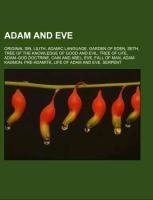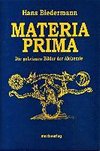
Adam and Eve
Source: Wikipedia. Pages: 86. Chapters: Original sin, Lilith, Adamic language, Garden of Eden, Seth, Tree of the knowledge of good and evil, Tree of life, Adam-God doctrine, Cain and Abel, Eve, Fall of Man, Adam Kadmon, Pre-Adamite, Life of Adam and Eve,... Viac o knihe
Produkt je dočasne nedostupný
20.68 €
bežná cena: 23.50 €
O knihe
Source: Wikipedia. Pages: 86. Chapters: Original sin, Lilith, Adamic language, Garden of Eden, Seth, Tree of the knowledge of good and evil, Tree of life, Adam-God doctrine, Cain and Abel, Eve, Fall of Man, Adam Kadmon, Pre-Adamite, Life of Adam and Eve, Serpent, Biblical figures in Islamic tradition, Adam-ondi-Ahman, Adam in rabbinic literature, The Creation of Adam, Adam's Peak, Generations of Adam, Al-Qurnah, Forbidden fruit, Cain and Abel in Islam, Sefer Raziel HaMalakh, Conflict of Adam and Eve with Satan, Islamic views on Adam, Expulsion from the Garden of Eden, Probe 7, Over and Out, Book of the Penitence of Adam, Books of Adam, Apocalypse of Adam, Tomb of Eve, Testament of Adam. Excerpt: Lilith (Hebrew: ¿; lilit, or lilith) is a character in Jewish mythology, found earliest in the Babylonian Talmud (completed between 500 and 700 AD/CE), who is generally thought to be related to a class of female demons Lili¿u in Mesopotamian texts. However, Lowell K. Handy (1997) notes, "Very little information has been found relating to the Akkadian and Babylonian view of these demons. Two sources of information previously used to define Lilith are both suspect." The two problematic sources are the Gilgamesh appendix and the Arslan Tash amulets, which are discussed below. In Jewish folklore, from the 8th-10th Century Alphabet of Ben Sira onwards Lilith becomes Adam's first wife, who was created at the same time and from the same earth as Adam. This contrasts with Eve, who was created from one of Adam's ribs. The legend was greatly developed during the Middle Ages, in the tradition of Aggadic midrashim, the Zohar and Jewish mysticism. In the 13th Century writings of Rabbi Isaac ben Jacob Alfasi ha-Cohen, for example, Lilith left Adam after she refused to become subservient to him and then would not return to the Garden of Eden after she mated with archangel Samael. The resulting Lilith legend is still commonly used as source material in modern Western culture, literature, occultism, fantasy, and horror. The semitic root L-Y-L layil in Hebrew, as layl in Arabic, means "night". Talmudic and Yiddish use of Lilith follows Hebrew. In Akkadian the terms lili and lilitu mean spirits. Some uses of lilitu are listed in The Assyrian Dictionary of the Oriental Institute of the University of Chicago (CAD, 1956, L.190), in Wolfram von Soden's Akkadisches Handwörterbuch (AHw, p. 553), and Reallexikon der Assyriologie (RLA, p. 47). The Sumerian she-demons lili have no etymologic relation to Akkadian lilu, "evening." Archibald Sayce (1882) considered that Hebrew lilit (or lilith) Hebrew: ¿; and Akkadian: lilitu are from proto-Semitic. Charles Fossey (1902) has this literally transl
- Vydavateľstvo: Books LLC, Reference Series
- Formát: Paperback
- Jazyk:
- ISBN: 9781155151922



 Anglický jazyk
Anglický jazyk 





 Nemecký jazyk
Nemecký jazyk 


